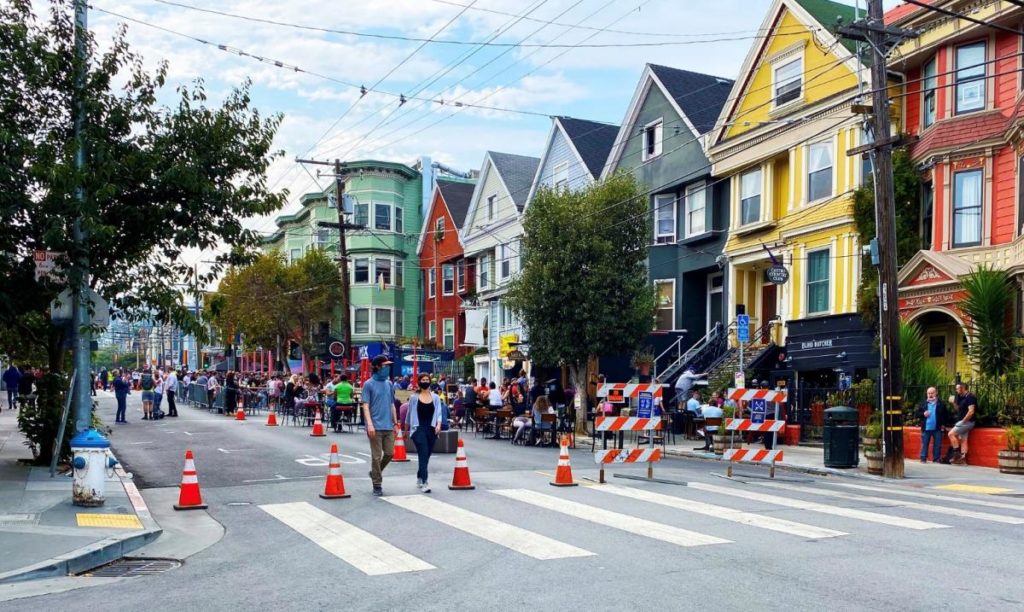
Smart cities proactively manage their partnerships to drive long-term outcomes

The second year of our Smart Cities Collaborative will tackle how new technologies and new mobility are reshaping the right-of-way and curb space via four key topics. Our third post in a series on these four topics examines how cities can develop public-private partnerships and use curb management strategies to drive long-term outcomes.
As we continue building a forum for collaboration and providing direct technical assistance to a new cohort of cities, the second year of the Collaborative will explore how new technologies and new mobility are reshaping the right-of-way and curb space. The content and curriculum will be separated into four sub-topics; design, measure, manage and price. Our third topic, manage, will cover best practices for establishing public-private partnerships, managing private providers in concert with public transit and using technology to manage curb space dynamically.
Manage
We’re in the midst of the most transformational shift in urban transportation in more than 50 years as new technology and mobility solutions are combining to change the landscape of cities. But, unlike that shift 50 years ago, spurred in part by the public creation of the interstate highway system, this transformation is largely being driven by the private sector. If cities are not mindful and intentional in driving the outcomes they seek, the benefits and costs of these changes will be unevenly and unfairly distributed.
Many cities, however, have often taken a “wait and see” approach. They have been unwilling, or someties unable, to use the regulatory authorities at their disposal to drive the outcomes they seek. To avoid a race to the bottom, cities need to lead the process, make deals, and negotiate with private mobility providers on their terms to ensure the benefits of these changes enhance opportunities for everyone.
Cities have also struggled to work with the private sector as these new models have been deployed in their communities. Much of this is due to the historical structures of cities and the experience gap between cities and the private sector. City governments have typically dealt with procuring multi-decade infrastructure projects and lack processes for regulating or permitting new modes such as transportation network companies, dockless bikeshare and others that want to operate in their jurisdiction and will have a measureable impact on their roads or transit networks.
Additionally, for services they do want or need such as an on-demand, micro-transit service or a data analytics platform, their procurement processes haven’t been designed for six-month pilot projects or rapidly updated digital products. This has been evident over the past decade as cities have signed agreements that don’t ultimately provide them with the data or services that meet their needs.
But, cities are beginning to realize that in addition to increasing their technical capacity in new and different ways, a cultural shift is necessary in order to design and manage these new projects and mobility options, drive the discussion with the private sector and maximize the positive benefits these tools can provide.
This year, the Collaborative will continue to serve as a forum for sharing strategies to effectively manage partnerships with the private sector and address how cities can get what they want and need. We’ll identify the carrots and sticks cities have at their disposal and can leverage in these discussions. We’ll work to standardize templates and agreements that can be shared across cities and adapted for their individual needs while examining some of the innovative procurement models that agencies are using to test new products and services.
As some of the primary assets under a city’s control, we’ll also take a deeper dive into managing road and curb space. Given that different city departments often oversee parking, ridehailing, or urban delivery and rarely collaborate, we’ll review the organizational changes some cities are making to meet this need. We’ll also examine the foundational data inventories that cities are creating to better understand their exisiting curb space, its current uses and how they’re determining demand. Coupling this work with the new street and curb space designs we explored in this post, we’ll help participants develop new strategies to effectively manage their road and curb space through various approaches such as flex-use and loading zones, performance-based parking and other context-sensitive strategies.
A strong component of these strategies will be dynamic pricing, so stay tuned for our next post on our fourth and last Collaborative topic this coming year — Price — and how cities can use pricing as a mechanism to manage demand, shore up municipal revenue streams and achieve their long-term goals.
And stay tuned — we’ll be announcing the cities selected to participate in year two of the Collaborative in just a few weeks.



